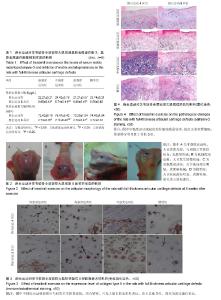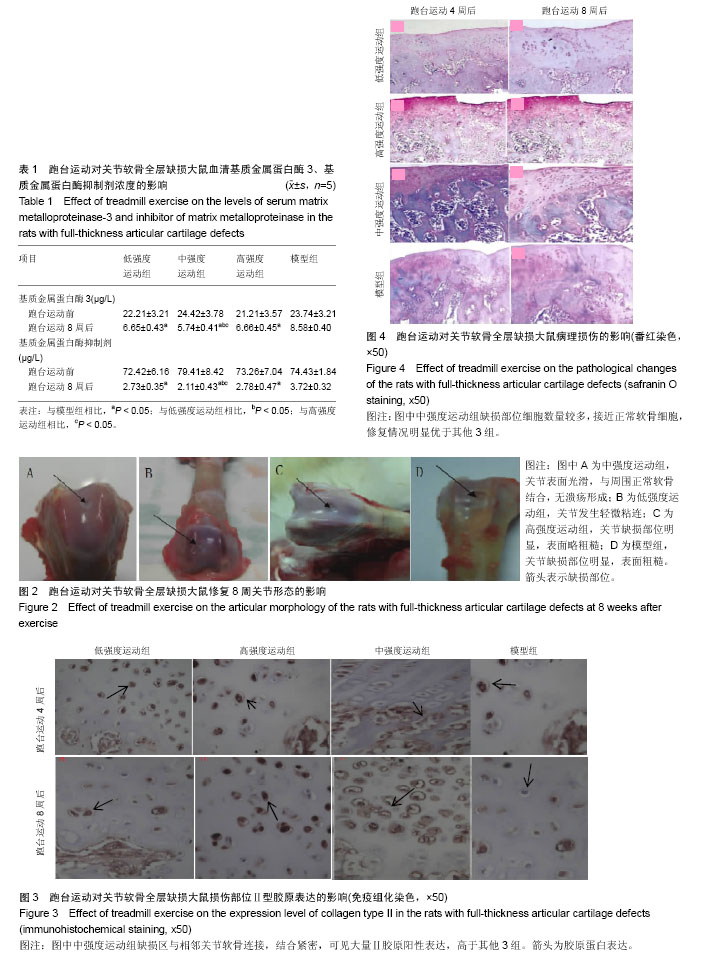Chinese Journal of Tissue Engineering Research ›› 2017, Vol. 21 ›› Issue (16): 2478-2483.doi: 10.3969/j.issn.2095-4344.2017.16.004
Previous Articles Next Articles
Effect of treadmill exercise on the repair of full-thickness knee cartilage defects
Zhao Sen-quan1, Mao Xin-run2
- 1Hebei Software Institute, Baoding 071000, Hebei Province, China; 2the Second Hospital of Hebei Medical University, Shijiazhuang 050000, Hebei Province, China
-
Revised:2017-04-22Online:2017-06-08Published:2017-07-06 -
Contact:Mao Xin-run, Master, Chief physician, the Second Hospital of Hebei Medical University, Shijiazhuang 050000, Hebei Province, China -
About author:Zhao Sen-quan, Lecturer, Hebei Software Institute, Baoding 071000, Hebei Province, China -
Supported by:the Key Medical Research Program of Hebei Province in 2016, No. 20160122
CLC Number:
Cite this article
Zhao Sen-quan, Mao Xin-run. Effect of treadmill exercise on the repair of full-thickness knee cartilage defects[J]. Chinese Journal of Tissue Engineering Research, 2017, 21(16): 2478-2483.
share this article

2.1 实验动物数量分析 40只大鼠全部进入结果分析,中途无脱落。 2.2 大体观察 4组大鼠跑台运动前精神状态较好,能正常饮食。模型组术后饮食差,2只大鼠切口发生感染,且活动较差。低强度运动组与高强度运动组治疗后饮食一般,切口均愈合,治疗后未见明显感染,活动一般;中强度运动组大鼠治疗后饮食良好,切口均愈合且未见感染,活动情况与跑台运动前接近。 跑台运动8周后,低强度运动组大鼠关节发生轻微粘连,软骨缺损部位有白色的类骨组织填充,并未与周围正常软骨结合,无溃疡形成。中强度运动组关节未见粘连,表面光滑,与周围正常软骨结合,无溃疡形成。高强度运动组缺损部位明显,表面略粗糙,无溃疡形成。模型组未采取任何处理,缺损部位明显,表面粗糙(图2)。 2.3 血清基质金属蛋白酶3、基质金属蛋白酶抑制剂浓度 4组大鼠跑台运动前血清基质金属蛋白酶3和基质金属蛋白酶抑制剂水平差异无显著性意义(P > 0.05);跑台运动8周后,低、中、高强度运动强度组血清基质金属蛋白酶3、基质金属蛋白酶抑制剂浓度低于模型组(P < 0.05),中强度运动组血清基质金属蛋白酶3、基质金属蛋白酶抑制剂浓度低于低、高强度运动强度组(P < 0.05;表1)。 2.4 Ⅱ型胶原含量 跑台运动4周后时,低强度运动组缺损区以类软骨组织为主,与相邻正常关节结合紧密,组织浅层可见Ⅱ型胶原表达;高强度运动组可见幼稚的细胞,与相邻关节软骨结合紧密,Ⅱ型胶原阳性表达较强。中强度运动组缺损区以纤维组织为主,与相邻关节软骨连接,结合紧密,有细胞生成,Ⅱ型胶原阳性表达率,高于模型组(P < 0.05;图3)。 跑台运动8周后时,低强度运动组在缺损区以类软骨组织修复,与周围关节软骨联系紧密,可见Ⅱ型胶原阳性表达,高于模型组(P < 0.05);高强度运动组跑台运动8周后可见较多的幼稚修复细胞,与相邻关节软骨结合紧密,细胞数量相对较少。中强度运动组缺损区与相邻关节软骨连接,结合紧密,可见大量II胶原阳性表达,高于其他3组(P < 0.05;图3)。 2.5 病理表现 番红染色结果显示,低强度运动组跑台运动4周后可见不成熟纤维细胞,排列紊乱,周围软骨无破坏且与修复组织间存在少许细胞;跑台运动8周后缺损部位仍未完全修复,缺损部位有陷窝,但是数量少。高强度运动组跑台运动4周后基质未见染色,缺损部位组织遭到明显破坏。跑台运动8周后缺损区无明显好转,仅底部薄层修复组织,周围软骨形成无细胞区,关节面恢复较差。中强度运动组跑台运动4周后缺损部位与正常组织两端结合,厚度基本正常,细胞数量较多,接近正常软骨细胞。跑台运动8周后缺损表面光滑,基质深染,细胞椭圆形,数量较多,接近正常软骨,模型组模型建立后未进行任何处理番红染色未见新生组织,缺损部位明显,见图4。"

| [1] 霍爱华,于彤,孙记航,等.宝石能谱CT在儿童脊柱侧弯术后CT影像中去除金属植入物伪影的应用[J].临床放射学杂志, 2013, 32(8):1180-1183.[2] 付卫光,丁军,张宝,等.多排螺旋CT去金属伪影技术在骨科内固定中的应用[J].中国实验诊断学,2012,16(3):488-489.[3] 陈财忠,李韧晨,张澍杰,等.去金属伪影序列在脊柱金属植入物患者MR成像中的应用[J].中华放射学杂志,2014,48(4):320-323.[4] Pezzotti G, Yamamoto K. Artificial hip joints: The biomaterials challenge. J Mech Behav Biomed Mater. 2014;31:3-20. [5] 蓝博文,周玉祥,黎昕,等.管径因素对冠状动脉支架CTA成像影响分析[J].中国CT和MRI杂志,2012,10(4):40-42.[6] 宣伟玲,赵凯宇,刘淼.宝石能谱CT在去除常见CT图像伪影中的应用[J].中国医疗设备,2013,28(1):157-158.[7] Russo V, Young S, Hamilton A, et al. Mesenchymal stem cell delivery strategies to promote cardiac regeneration following ischemic injury. Biomaterials. 2014;35(13): 3956-3974. [8] Leto Barone AA, Khalifian S, Lee WP, et al. Immunomodulatory effects of adipose-derived stem cells: fact or fiction? Biomed Res Int. 2013;2013:383685.[9] 黄钟杰,刘源,肖芝豹,等.宝石CT能谱成像去除脊柱金属植入物伪影的应用研究[J].中国医学计算机成像杂志, 2013,19(1):79-83.[10] 陈敏,徐贤,韩邵军,等.磁共振T2mapping成像对移植软骨的评估价值[J].中国医学科学院学报,2014,36(1):86-91.[11] 冯强,矫玮,郑文伯,等.预防女足运动员严重膝关节韧带损伤的方法初探[J].运动,2014(24):15-16.[12] Theodoropoulos JS, DeCroos AJ, Petrera M, et al. Mechanical stimulation enhances integration in an in vitro model of cartilage repair. Knee Surg Sports Traumatol Arthrosc. 2016;24(6):2055-2064. [13] Ni GX, Liu SY, Lei L, et al. Intensity-dependent effect of treadmill running on knee articular cartilage in a rat model. Biomed Res Int. 2013;2013:172392. [14] 刘宪民,杜明昌,刘松波,等.一期获取自体脂肪干细胞复合可缓释诱导因子支架修复猪膝关节软骨缺损的初步研究[J].中华创伤骨科杂志,2012,14(7):608-613.[15] 李忆农.细胞因子与骨关节炎[J].中华风湿病学杂志, 2000,4(1): 56-58.[16] Knapik DM, Harrison RK, Siston RA, et al. Impact of lesion location on the progression of osteoarthritis in a rat knee model. J Orthop Res. 2015;33(2):237-245. [17] 杜明昌,刘宪民,祖启明,等.自体脂肪干细胞复合不同初始浓度诱导支架修复猪膝关节软骨缺损的初步观察[J].中华临床医师杂志, 2013(6):2523-2527.[18] McNulty AL, Rothfusz NE, Leddy HA, et al. Synovial fluid concentrations and relative potency of interleukin-1 alpha and beta in cartilage and meniscus degradation. J Orthop Res. 2013;31(7):1039-1045. [19] 金丽娟,汪玉海.携带HGF基因的脐带血干细胞异种移植促进烧伤创面修复的实验研究[J].宁夏医学杂志, 2013,35(11):1033-1035.[20] La Rocca G, Lo Iacono M, Corsello T, et al. Human Wharton's jelly mesenchymal stem cells maintain the expression of key immunomodulatory molecules when subjected to osteogenic, adipogenic and chondrogenic differentiation in vitro: new perspectives for cellular therapy. Curr Stem Cell Res Ther. 2013;8(1):100-113.[21] 马洪斌,李运祥,王铭伦.腺病毒携带骨形态发生蛋白14基因转染脂肪干细胞修复损伤关节软骨[J].中国组织工程研究,2015, 19(1): 54-60.[22] 袁虹,张解元,张荣明.BMP-14 转染脂肪来源干细胞后与软骨细胞共培养的实验研究[J].中国修复重建外科杂志, 2012,27(3): 349-353.[23] Baugé C, Girard N, Lhuissier E, et al. Regulation and Role of TGFβ Signaling Pathway in Aging and Osteoarthritis Joints. Aging Dis. 2013;5(6):394-405. [24] 王岩,李德华.骨髓间充质干细胞复合多肽凝胶及成软骨生成因子修复兔关节软骨缺损[J].中国组织工程研究, 2015,19(1): 30-36.[25] Re'em T, Witte F, Willbold E, et al. Simultaneous regeneration of articular cartilage and subchondral bone induced by spatially presented TGF-beta and BMP-4 in a bilayer affinity binding system. Acta Biomater. 2012;8(9):3283-3293. [26] Kim K, Lam J, Lu S, et al. Osteochondral tissue regeneration using a bilayered composite hydrogel with modulating dual growth factor release kinetics in a rabbit model. J Control Release. 2013;168(2):166-178. [27] Lu S, Lam J, Trachtenberg JE, et al. Dual growth factor delivery from bilayered, biodegradable hydrogel composites for spatially-guided osteochondral tissue repair. Biomaterials. 2014;35(31):8829-8839. [28] Guo X, Park H, Young S, et al. Repair of osteochondral defects with biodegradable hydrogel composites encapsulating marrow mesenchymal stem cells in a rabbit model. Acta Biomater. 2010;6(1):39-47. [29] Park H, Temenoff JS, Tabata Y, et al. Effect of dual growth factor delivery on chondrogenic differentiation of rabbit marrow mesenchymal stem cells encapsulated in injectable hydrogel composites. J Biomed Mater Res A. 2009;88(4): 889-897.[30] Miller RE, Grodzinsky AJ, Barrett MF, et al. Effects of the combination of microfracture and self-assembling Peptide filling on the repair of a clinically relevant trochlear defect in an equine model. J Bone Joint Surg Am. 2014;96(19): 1601-1609. [31] Sun X, Li C, Zhuang C, et al. Abl interactor 1 regulates Src-Id1-matrix metalloproteinase 9 axis and is required for invadopodia formation, extracellular matrix degradation and tumor growth of human breast cancer cells. Carcinogenesis. 2009;30(12):2109-2116. [32] Clark ES, Whigham AS, Yarbrough WG, et al. Cortactin is an essential regulator of matrix metalloproteinase secretion and extracellular matrix degradation in invadopodia. Cancer Res. 2007;67(9):4227-4235. [33] Sherief MH, Low SH, Miura M, et al. Matrix metalloproteinase activity in urine of patients with renal cell carcinoma leads to degradation of extracellular matrix proteins: possible use as a screening assay. J Urol. 2003;169(4):1530-1534. [34] Whiteside EJ, Jackson MM, Herington AC, et al. Matrix metalloproteinase-9 and tissue inhibitor of metalloproteinase-3 are key regulators of extracellular matrix degradation by mouse embryos. Biol Reprod. 2001;64(5): 1331-1337. [35] Ishizeki K, Nawa T. Further evidence for secretion of matrix metalloproteinase-1 by Meckel's chondrocytes during degradation of the extracellular matrix. Tissue Cell. 2000; 32(3):207-215. [36] Greenwald RA. Controlling extracellular matrix degradation: is the promised land in sight? Or why I take a matrix metalloproteinase inhibitor every morning. Isr Med Assoc J. 1999;1(4):262-266. [37] Leontovich AA, Zhang J, Shimokawa K, et al. A novel hydra matrix metalloproteinase (HMMP) functions in extracellular matrix degradation, morphogenesis and the maintenance of differentiated cells in the foot process. Development. 2000; 127(4):907-920. [38] Mattana J, Margiloff L, Chaplia L. Oxidation of extracellular matrix modulates susceptibility to degradation by the mesangial matrix metalloproteinase-2. Free Radic Biol Med. 1999;27(3-4):315-321. [39] Shapiro SD. Matrix metalloproteinase degradation of extracellular matrix: biological consequences. Curr Opin Cell Biol. 1998;10(5):602-608. [40] Ohnishi K, Takagi M, Kurokawa Y, et al. Matrix metalloproteinase-mediated extracellular matrix protein degradation in human pulmonary emphysema. Lab Invest. 1998;78(9):1077-1087.[41] 姚兴豹,邰东旭.新止骨增生丸与薰洗方熏蒸联合膝关节镜清理术治疗早中期膝关节骨性关节炎46例临床观察[J].实用中医内科杂志,2014,7(6):97-99.[42] 王晓华.中药联合抗风湿药治疗类风湿性关节炎活动期的临床观察[J].中国卫生标准管理,2015,6(12):106-107. |
| [1] | Wang Jianping, Zhang Xiaohui, Yu Jinwei, Wei Shaoliang, Zhang Xinmin, Xu Xingxin, Qu Haijun. Application of knee joint motion analysis in machanism based on three-dimensional image registration and coordinate transformation [J]. Chinese Journal of Tissue Engineering Research, 2022, 26(在线): 1-5. |
| [2] | Yao Xiaoling, Peng Jiancheng, Xu Yuerong, Yang Zhidong, Zhang Shuncong. Variable-angle zero-notch anterior interbody fusion system in the treatment of cervical spondylotic myelopathy: 30-month follow-up [J]. Chinese Journal of Tissue Engineering Research, 2022, 26(9): 1377-1382. |
| [3] | Wu Bingshuang, Wang Zhi, Tang Yi, Tang Xiaoyu, Li Qi. Anterior cruciate ligament reconstruction: from enthesis to tendon-to-bone healing [J]. Chinese Journal of Tissue Engineering Research, 2022, 26(8): 1293-1298. |
| [4] | Zhang Jinglin, Leng Min, Zhu Boheng, Wang Hong. Mechanism and application of stem cell-derived exosomes in promoting diabetic wound healing [J]. Chinese Journal of Tissue Engineering Research, 2022, 26(7): 1113-1118. |
| [5] | An Weizheng, He Xiao, Ren Shuai, Liu Jianyu. Potential of muscle-derived stem cells in peripheral nerve regeneration [J]. Chinese Journal of Tissue Engineering Research, 2022, 26(7): 1130-1136. |
| [6] | Shao Yangyang, Zhang Junxia, Jiang Meijiao, Liu Zelong, Gao Kun, Yu Shuhan. Kinematics characteristics of lower limb joints of young men running wearing knee pads [J]. Chinese Journal of Tissue Engineering Research, 2022, 26(6): 832-837. |
| [7] | Zhou Jianguo, Liu Shiwei, Yuan Changhong, Bi Shengrong, Yang Guoping, Hu Weiquan, Liu Hui, Qian Rui. Total knee arthroplasty with posterior cruciate ligament retaining prosthesis in the treatment of knee osteoarthritis with knee valgus deformity [J]. Chinese Journal of Tissue Engineering Research, 2022, 26(6): 892-897. |
| [8] | Wei Xing, Liu Shufang, Mao Ning. Roles and values of blood flow restriction training in the rehabilitation of knee joint diseases [J]. Chinese Journal of Tissue Engineering Research, 2022, 26(5): 774-779. |
| [9] | Chen Xiaoxu, Luo Yaxin, Bi Haoran, Yang Kun. Preparation and application of acellular scaffold in tissue engineering and regenerative medicine [J]. Chinese Journal of Tissue Engineering Research, 2022, 26(4): 591-596. |
| [10] | Kang Kunlong, Wang Xintao. Research hotspot of biological scaffold materials promoting osteogenic differentiation of bone marrow mesenchymal stem cells [J]. Chinese Journal of Tissue Engineering Research, 2022, 26(4): 597-603. |
| [11] | Shen Jiahua, Fu Yong. Application of graphene-based nanomaterials in stem cells [J]. Chinese Journal of Tissue Engineering Research, 2022, 26(4): 604-609. |
| [12] | Zhang Tong, Cai Jinchi, Yuan Zhifa, Zhao Haiyan, Han Xingwen, Wang Wenji. Hyaluronic acid-based composite hydrogel in cartilage injury caused by osteoarthritis: application and mechanism [J]. Chinese Journal of Tissue Engineering Research, 2022, 26(4): 617-625. |
| [13] | Li Hui, Chen Lianglong. Application and characteristics of bone graft materials in the treatment of spinal tuberculosis [J]. Chinese Journal of Tissue Engineering Research, 2022, 26(4): 626-630. |
| [14] | Gao Cangjian, Yang Zhen, Liu Shuyun, Li Hao, Fu Liwei, Zhao Tianyuan, Chen Wei, Liao Zhiyao, Li Pinxue, Sui Xiang, Guo Quanyi. Electrospinning for rotator cuff repair [J]. Chinese Journal of Tissue Engineering Research, 2022, 26(4): 637-642. |
| [15] | He Yunying, Li Lingjie, Zhang Shuqi, Li Yuzhou, Yang Sheng, Ji Ping. Method of constructing cell spheroids based on agarose and polyacrylic molds [J]. Chinese Journal of Tissue Engineering Research, 2022, 26(4): 553-559. |
| Viewed | ||||||
|
Full text |
|
|||||
|
Abstract |
|
|||||